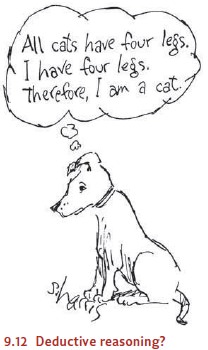Chapter: Psychology: Thinking
Reasoning: Faulty Logic
Faulty Logic
When people fall prey to
confirmation bias, their thinking seems illogical: “If I know how to pick
winners, then I should win my bets. In fact, though, I lose my bets. Therefore,
I know how to pick winners.” But could this be? Are people really this
illog-ical in their reasoning? One way to find out is by asking people to solve
simple prob-lems in logic—for example, problems involving syllogisms.
A syllogism contains two premises
and a conclusion, and the question is whether the conclusion follows logically
from the premises; if it does follow, we say that the conclu-sion is valid. Figure 9.11 offers several
examples; and let’s be clear that in these (or any) syllogisms, the validity of
the conclusion depends only on the premises. It doesn’t mat-ter if the
conclusion is plausible or not, in light of other things you know about the
world. It also doesn’t matter if the premises happen to be true or not. All
that matters is the relationship between the premises and the conclusion—and,
in particular, whether the conclusion must be true if the premises are true.

Syllogisms seem straightforward,
and so it’s disheartening that people make an enormous number of errors in
evaluating them. To be sure, some syllogisms are easier than others—and so
participants are more accurate, for example, if a syllogism is set in concrete
terms rather than abstract symbols. Still, across all the syllogisms, mistakes
are frequent, and error rates are sometimes as high as 70 or 80% (Gilhooly,
1988).
What produces this high error
rate? Despite careful instructions and considerable coaching, many participants
seem not to understand what syllogistic reasoning requires. Specifically, they
seem not to get the fact that they’re supposed to focus only on the
relationship between the premises and conclusion. They focus instead on whether
the conclusion seems plausible on its own—and if it is, they judge the
syllo-gism to be valid (Klauer, Musch, & Naumer, 2000). Thus, they’re more
likely to endorse the conclusion “Therefore all artwork should be cherished” in
Figure 9.11 than they are to endorse the conclusion “Therefore all artwork can
be turned into clocks.” Both of these conclusions are warranted by their
premises, but the first is plausible and so more likely to be accepted as
valid.
In some ways, this reliance on
plausibility is a sensible strategy. Participants are doing their best to
assess the syllogisms’ conclusions based on all they know (cf. Evans &
Feeney, 2004). At the same time, this strategy implies a profound
misunderstanding of the rules of logic (Figure 9.12). With this strategy,
people are willing to endorse a bad argument if it happens to lead to conclusions
they already believe are true, and they’re willing to reject a good argument if
it leads to conclusions they already believe are false.

Related Topics